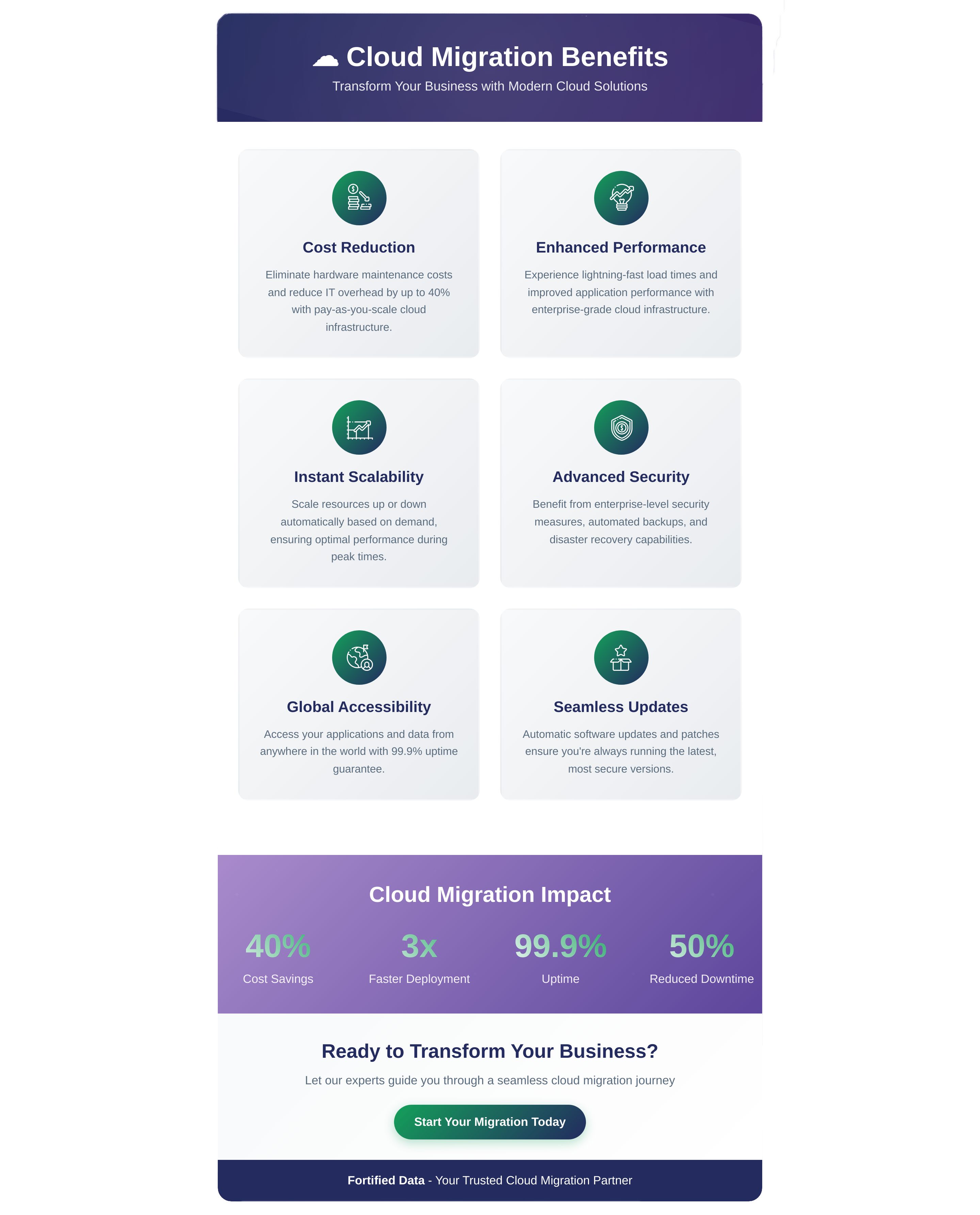As organizations seek greater agility, cost-efficiency, and scalability, cloud migration services have emerged as a critical pathway for digital transformation. Whether you’re moving legacy systems to Amazon Web Services (AWS), Microsoft Azure, or Google Cloud Platform (GCP), the cloud offers a new way to think about infrastructure, performance, and innovation.
But successful cloud migration isn’t as simple as flipping a switch. It requires a thoughtful, well-structured approach to avoid disruption and achieve long-term value.
In this guide, we’ll break down what cloud migration really means, explore its benefits and challenges, and walk you through the essential steps in a successful cloud migration process—plus how Fortified Data can help you make it seamless.
What Are Cloud Migration Services?
Cloud migration services refer to the strategies, processes, tools, and expertise used to move an organization’s digital assets—applications, data, servers, and workflows—from on-premises infrastructure to a cloud-based environment.
This migration can take many forms:
- Lift-and-shift (rehosting): Moving workloads as-is to the cloud.
- Refactoring/re-architecting: Modifying applications to leverage cloud-native capabilities.
- Replatforming: Making minor adjustments to optimize for the new environment.
- Hybrid cloud migration: Splitting workloads between on-prem and cloud.
- Multi-cloud migration: Spreading systems across more than one cloud provider.
Cloud migration services also include critical support areas like security hardening, compliance alignment, disaster recovery planning, and post-migration performance tuning.
Benefits of Cloud Migration
Migrating to the cloud can unlock major advantages for your business:
- Scalability on demand: Quickly scale resources up or down based on workload needs.
- Improved performance: Cloud platforms provide global availability, faster response times, and modernized infrastructure.
- Cost optimization: Move from CapEx-heavy infrastructure to OpEx-based pricing. Only pay for what you use.
- Business continuity and resilience: Cloud providers offer built-in redundancy, backups, and failover capabilities.
- Enhanced security and compliance: With proper configurations, cloud platforms offer strong encryption, role-based access, and regular compliance updates.
Challenges of Cloud Migration
While the benefits are compelling, cloud migration can come with real risks if not properly managed:
- Downtime or data loss: Poor planning or testing can lead to service disruption or incomplete data transfers.
- Cost overruns: Without monitoring and right-sizing, cloud costs can spiral.
- Security misconfigurations: Improper access controls or exposed endpoints can leave your environment vulnerable.
- Application compatibility issues: Legacy applications may require refactoring before they run smoothly in the cloud.
That’s why it’s crucial to have experienced cloud migration consulting services involved—partners who know how to assess, plan, and execute with minimal disruption.
What You Should Understand Before Migrating to the Cloud
Before beginning your migration, make sure your team understands:
- What data and applications are being moved: Inventory everything and map dependencies to avoid surprises.
- How your cloud environment will be structured: Decide on single cloud, multi-cloud, or hybrid strategies.
- Who owns security in the shared responsibility model: Know where your provider’s responsibility ends and yours begins.
- Your RTO and RPO goals: Define Recovery Time Objective and Recovery Point Objective before building the environment.
- Your compliance and regulatory obligations: Ensure your cloud provider and design meet industry standards (HIPAA, SOC 2, PCI, etc.).
Framework for a Successful Cloud Migration
A best-practice cloud migration process typically includes:
1. Assessment & Discovery – Evaluate your current environment, workloads, licensing, compliance, and application dependencies.
2. Strategy & Planning – Define your goals, migration type (lift-and-shift, refactor, etc.), and develop a cloud architecture roadmap.
3. Design & Provisioning – Build and test the new cloud environment, including networking, storage, IAM policies, and monitoring.
4. Cloud Data Migration – Migrate databases, file systems, and application data with encryption and validation to ensure integrity.
5. Application Migration – Move applications, reconfigure dependencies, and validate functionality in the new environment.
6. Testing & Cutover – Conduct full UAT (User Acceptance Testing), failover testing, and finalize the switch to cloud.
7. Post-Migration Optimization – Monitor performance, right-size instances, implement autoscaling, and configure backups and alerts.
How Long Does a Cloud Migration Take?
The duration of a cloud migration depends on several factors:
- Size and complexity of workloads
- Type of migration (lift-and-shift vs. re-architecting)
- Testing and compliance needs
- Availability of internal resources
For small organizations or limited workloads, a migration may take 4–6 weeks. For mid-market and enterprise environments, timelines often range from 3 to 9 months, especially when databases, ERP systems, or mission-critical apps are involved.

How Fortified Data Can Help
At Fortified Data, we understand that cloud migration isn’t just an IT project—it’s a strategic transformation.
Our cloud migration services combine deep database expertise with cloud-native architecture and proven execution frameworks. We don’t just move your systems—we modernize them for long-term scalability, security, and performance.
What Sets Us Apart:
- Database-first approach: Unlike generalist firms, we specialize in complex data environments—SQL Server, Oracle, MySQL, PostgreSQL—and ensure zero data loss during migrations.
- Custom migration strategies: We tailor our cloud migration consulting services to your business, whether it’s a hybrid solution, full migration, or phased approach.
- Resiliency built in: Compliance, DR, and HA are embedded into our designs—not added on later.
- Post-migration optimization: Through our CoreHealth 365 platform, we provide continuous monitoring, patching, and performance tuning long after go-live.
Whether you’re planning a migration to Azure, AWS, or GCP—or exploring a hybrid or multi-cloud model—we help you do it with confidence.
Read Our Cloud Migration Whitepaper
Learn about the full process of cloud migration and the benefits it brings.
Learn More About Our Cloud Migration Services
Learn more about how Fortified Data can assist you with cloud migrations

